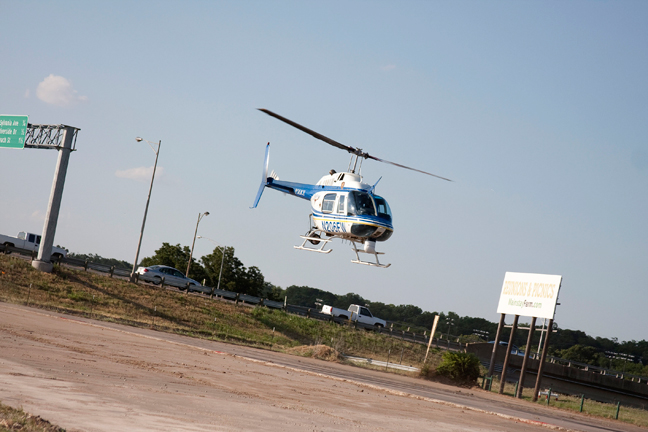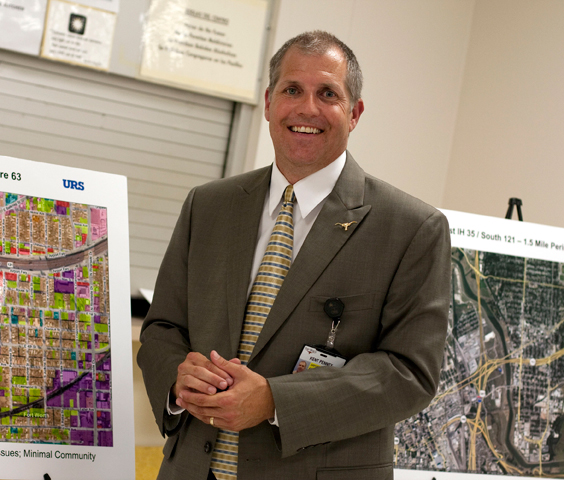When the city of Fort Worth announced plans in May to build a public heliport near downtown, the reasons given were not surprising. The heliport complex just east of I-35W would help boost downtown business and open in time for the Super Bowl in February 2011. Basic theme of the city staff recommendation: Other cities — including Dallas — have public downtown heliports, and Fort Worth needs one too.

The city staffers emphasized that no tax dollars will be used to build the heliport. But with the city facing a budget shortfall of more than $70 million for fiscal 2011 — and with many city programs facing cuts — a lot of folks are still wondering how and why the city is finding money for a project that will cost $5 million to $8 million.
The “why,” apparently, is to shave seven minutes off the time it will take ’copter passengers to get from a Fort Worth heliport to downtown by car. The city already has helicopter service at Meacham International Airport, a 12-minute drive from Sundance Square. The city’s web site actually plays up the nearness of Meacham to the city center, calling the airport “North Texas’s premier general aviation facility just five miles from historic downtown Fort Worth.”
The proposed site for the new heliport would be about two miles — or five minutes — east of downtown, on about 30 acres between I-35W and the Trinity River just south of Airport Freeway. According to the city study, about 38 percent of traffic at the heliport would come from corporate executives and another 16 percent from sightseers. There’s another city heliport just about as close that’s now used by police. But officials said that facility is unsuitable.
The “how” is easier to explain, but also problematic: The city would use revenue from gas wells drilled beneath the city’s three airports — Meacham, Spinks, and Alliance. Federal Aviation Administration policy severely limits what airport gas drilling revenues can be used for: It all has to stay at city-owned airports.
 That policy was instituted in 1999, before the Barnett Shale boom took off, and it’s becoming controversial in cities around the country where shale drilling is heating up. The rule keeps local governments from being able to move sizable chunks of income around to where it’s needed most — a restriction that grows more irksome as more and more cities and counties encounter fiscal problems.
That policy was instituted in 1999, before the Barnett Shale boom took off, and it’s becoming controversial in cities around the country where shale drilling is heating up. The rule keeps local governments from being able to move sizable chunks of income around to where it’s needed most — a restriction that grows more irksome as more and more cities and counties encounter fiscal problems.
Because airports encompass large tracts of land (more than 1,700 acres among the three in Fort Worth), gas drilling money adds up quickly. In March, the city had $23 million in its Aviation Gas Lease Project Fund, from which money for the heliport would be drawn. Additionally, the city has $13 million tied up in an Aviation Endowment Fund, also based on drilling income, from which only the investment revenue, not the principal, is spent. So far the endowment fund has generated a little more than $300,000 in the past three years, and only $87,000 has been spent on aviation projects.
Over the life of those wells, income to Fort Worth could total $150 million to $300 million, depending on gas prices. And all that money would have to stay in the aviation department, where the total annual budget for the three airports is about $4 million, covered by landing fees and hangar rental, and with improvements paid for largely by the FAA.
At a city-sponsored public hearing on the heliport two weeks ago at the Andrew “Doc” Session Community Center near the planned heliport site, some residents raised concerns about added noise in their neighborhood. The heliport would operate 24 hours a day.
But community activist Cory Session had a broader view of the objections to spending millions on a downtown heliport. “There is all sorts of talk about closing community centers in this town, including this one,” said Session, the nephew of “Doc” Session, for whom the center is named.
“The city has closed pools, and now they are looking to close or cut back community centers, but they are finding money to land private helicopters 1,000 feet away from this community center,” Session said. “The city says they have no choice but to use the drilling money from the airports for projects like this. But why not lobby the federal government to change their policy?”
Some Cowtown residents have lobbied hard behind the scenes to convince the city to request that the FAA change its drilling revenue policy. But to date there has been no such formal request by the city council. The most frequently suggested change would allow government entities to use funds from airport gas drilling for any transportation project — roads, bridges, or mass transit.
Across the country, cities and counties are finding out about the FAA policy and talking with their congressional representatives about changing it. This is happening most in the Marcellus Shale areas in Pennsylvania, New York, and West Virginia.
Allegheny County in Pennsylvania operates two airports and is close to signing deals with drilling companies. County leaders thought they could use the revenues to cover budget shortfalls in the county’s general fund. But then they discovered the FAA policy and promptly called Washington.
“We’re looking at all of our options to make sure the airports and taxpayers benefit from the drilling,” said Allegheny County spokeswoman Megan Dardanell. The county owns the airport properties, including the mineral rights, and leases the land to an airport authority, she said. Dardanell said the county is in the early phases “of exploring our next steps.”
What makes Fort Worth’s situation unique is that the city’s three airports have no passenger service. Big commercial hub airports like Dallas/Fort Worth International have a much higher level of expenses in maintaining terminals and moving passengers around, so retaining the drilling revenue at those types of airports makes more sense.
Kent Penney, the city’s airport system director, said the downtown heliport should be built “because the demand is there, and we can use the gas drilling money for capital improvements that will create better accessibility to downtown.” But he did acknowledge that, given the budget crisis, the city would probably not be proposing the downtown heliport if there were no gas money.
The city also owns a heliport on Nixon Street, two miles north of downtown near Cold Spring Park. It is used exclusively by the Fort Worth Police Department. Penney said that heliport was not considered for expansion “because of accessibility issues” and “structural problems in the hangar.”
Expansion of the police heliport would be difficult because it sits near the Trinity River Vision project. But accessibility did not appear to be an issue; a recent drive from there to downtown was quick and easy.
Meacham is not adequate, Penney said, because it does not have enough hangar space. “The additional hangar space for the downtown heliport will free up hanger space at Meacham Field, and we will be able to accommodate more fixed-wing aircraft there,” he said.
A city survey intended to judge the potential demand for a downtown heliport produced mixed results. There are 423 helicopters registered by the FAA in the eight-county North Texas area. But the city sent the survey to more than 900 helicopter owners within 300 miles of Fort Worth. City staffers said 75 percent of those who responded indicated they would use a downtown heliport, and 35 percent said they would use it more than 10 times a month.
At the public hearing, Penney disclosed a Dallas connection. Business leaders in Big D would be much more likely to fly into a downtown heliport in Fort Worth, Penney said, than the one at Meacham Field, due to the time it would take to get into downtown from the North Side. He made the point that the extra seven minutes from Meacham could be a deal-breaker for Dallasites doing business in Fort Worth and also said operating costs at the heliport would be covered by landing fees and hangar rentals.
For Cory Session, the problem with the heliport project is timing. “We have been told the city needs $450,000 to keep the community centers open, and they don’t have it,” he said. “But they have $5 million for a heliport that I don’t think will be used much. And certainly not by ordinary citizens of this city.”











